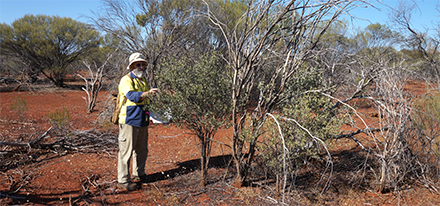 Forest Products Commission (FPC) staff members re-assessed previous Western Australian sandalwood trials to collect new data.Technical Support Manager Jon Brand said the sandalwood trials were established in semi-arid regions near Paynes Find (Ninghan and Burnerbinmah) and Menzies (Goongarrie) by Conservation and Land Management in 1996. Source: Timberbiz
Forest Products Commission (FPC) staff members re-assessed previous Western Australian sandalwood trials to collect new data.Technical Support Manager Jon Brand said the sandalwood trials were established in semi-arid regions near Paynes Find (Ninghan and Burnerbinmah) and Menzies (Goongarrie) by Conservation and Land Management in 1996. Source: Timberbiz
“The aims of the trials were to study natural sandalwood population structure changes over time and also to investigate the benefits of seed enrichment,” Mr. Brand said.
“Unfortunately, many of the natural sandalwood populations are declining especially in the Paynes Find region, due to a lack of natural seed dispersal, grazing and reduced winter rainfall patterns.”
Small marsupials, including Woylies and Boodies, used to promote sandalwood regeneration by caching seeds, but these marsupials have been absent from these regions for more than 70 years.
“We were pleased to see that the old seed enrichment trials were continuing to survive and grow in a range of locations, with survival rates, from total seeds sown, around one to 5% and stem diameter growth rates were about one to two millimetres a year,” Mr Brand said.
Even though these sandalwood survival and growth rates seem low, they are good results for sandalwood in these dry areas.
“These long-term figures are very useful for long-term regeneration planning in these semi-arid environments,” Mr Brand said.





